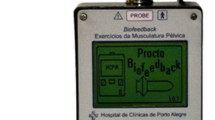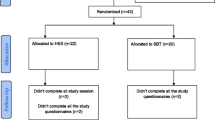Abstract
Twenty children aged 6–18 years who had deficient fecal continence after primary and secondary surgery for anorectal malformations were treated by biofeedback conditioning. The original malformation was high in 17 cases and low in 3. Pretreatment manometric assessments and training were performed with a perfused open-tip catheter connected to a recording unit where the manometric tracings could be inspected digitally or from the pressure curve. A latex balloon was used to stimulate the rectum. The patients were taught to develop maximal sphincter contraction and synchronize the contraction with rectal distention. Rectal sensitivity was conditioned by gradually decreased balloon volumes. There were 4–11 training sessions. The follow-up time was 2–24 months. Sixteen of the 20 patients responded favorably to the training. Fecal continence and the ability to take part in a normal social life improved significantly in the responders. In the responders, the contractile power of the sphincter increased significantly while other manometric parameters (basal anal canal pressure, rectal sensitivity, rectal capacity, rectoanal inhibitory reflux) could not be influenced. Biofeedback is a safe, simple, and effective method in treating fecal incontinence associated with anorectal malformations.
Similar content being viewed by others
References
Cerulli MA, Nikoomanesh P, Schuster MM (1979) Progress in biofeedback conditioning for fecal incontinence. Gastroenterology 76: 742–746
Engel BT, Nikoomanesh P, Schuster MM (1974) Operant conditioning of rectosphincteric responses in the treatment of fecal incontinence. N Engl J Med 290: 646–649
Holschneider AM (1983) Elektromanometrie des Enddarms. Urban & Schwarzenberg, München Wien Baltimore, pp 57–80
Holschneider AM (1983) Elektromanometrie des Enddarms. Urban & Schwarzenberg, München Wien Baltimore, pp 213–218
Koltai JL, Ohama K, Hofmann-v.-Kap-herr S, Pistor G (1984) Optisch-akustisch analoges Biofeedback-Conditioning zur Behandlung der Stuhlinkontinenz im Kindesalter. Z Kinderchir 39: 389–391
MacLeod JH (1982) Biofeedback in the management of partial anal incontinence. Dis Colon Rectum 26: 244–246
Meunier P, Mollard P, Jaubert de Beaujeu M (1976) Manometric studies of anorectal disorders in infancy and childhood: an investigation of the physiopathology of continence and defecation. Br J Surg 63: 402
Olness K, McParland FA, Piper J (1980) Biofeedback: a new modality in the management of children with fecal soiling. J Pediatr 96: 505–509
Wald A (1981) Biofeedback therapy for fecal incontinence. Ann Intern Med 95: 146–149
Wald A (1981) Use of biofeedback in treatment of fecal incontinence in patients with meningomyelocele. Pediatrics 68: 45–49
Author information
Authors and Affiliations
Rights and permissions
About this article
Cite this article
Rintala, R., Lindahl, H. & Louhimo, I. Biofeedback conditioning for fecal incontinence in anorectal malformations. Pediatr Surg Int 3, 418–421 (1988). https://doi.org/10.1007/BF00173458
Issue Date:
DOI: https://doi.org/10.1007/BF00173458




